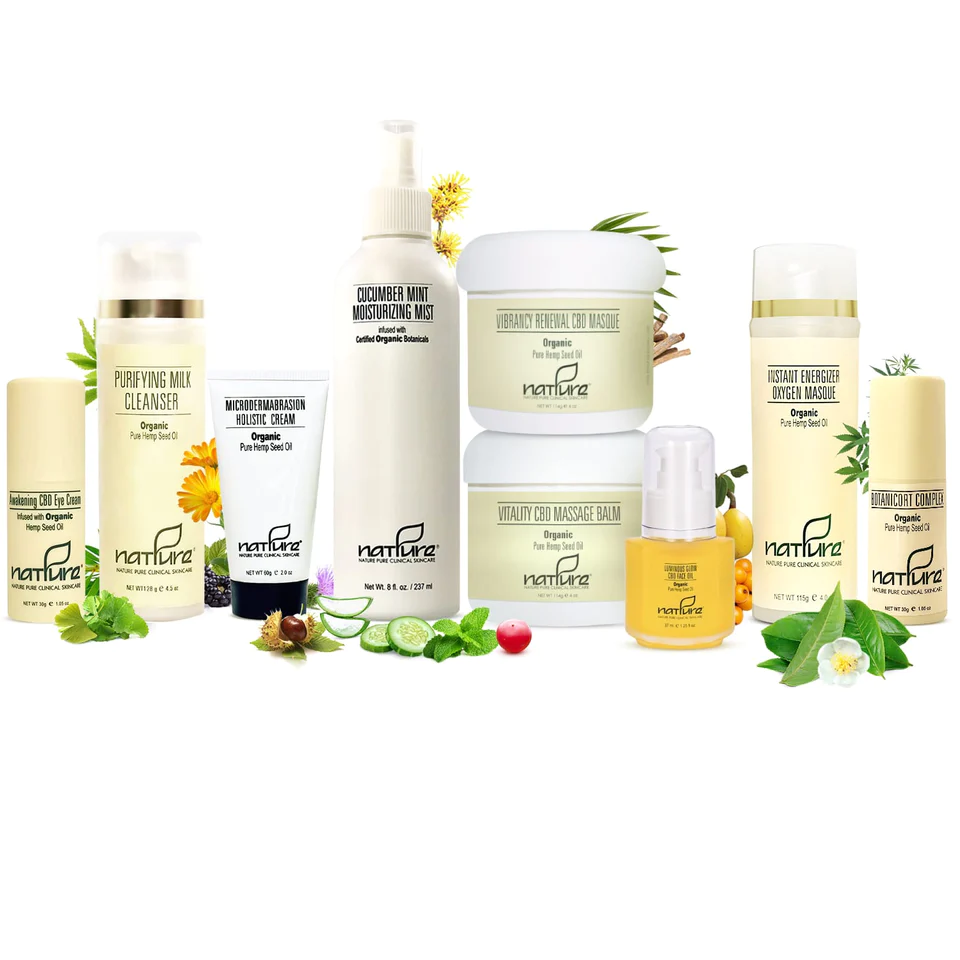Best ingredients for acne, fine lines, Rosacea, and hyperpigmentation!
Throughout the decades, there has been an abundance of modern science and breakthrough technologies that have emerged, and yet, it is no surprise that many of the traditional practices utilizing botanicals for beautification and healing, still, hold just as strong of a position in supporting wellness, beauty and skin health. In true holistic essence, the ideal strategy to achieve the best results that promote overall skin and body well-being and appearance is tapping into the best of both worlds. Throughout history, botanicals have been a kind offering of Mother Nature. A botanical ingredient broadly means any plant-based substance, this includes herbs, fruits, and nuts. Botanicals have provided countless remedies and solutions for a wide range of skin concerns, including for the treatment and care of acne, fine lines and wrinkles, rosacea, hyperpigmentation, and simply, to support optimal health.
Fine Lines + Wrinkles
Creases that develop on the skin are typically either aging or age-indicating. For the record, who cares, it’s just a number. Some fine lines and wrinkles may be premature and others chronological. Botanicals can work wonders in prolonging a youthful appearance especially if they are intertwined with holistic skin and body rituals practiced continuously throughout the years. Hippophae berries also known as sea buckthorn, soy isoflavones, plant stem cells, resveratrol, and tea, including green, black, and white are the notable botanical ingredients that work to defy skin aging.

Nature Pure Clinical Skincare
Skin Awakening Cannabis Renewal Facial
This facial treatment has Anti-Inflammatory benefits that work to alleviate redness or skin irritation. It contains high doses of antioxidants and omegas to nourish the skin. It offers Instant glow and enhancement of complexion. It provides age prevention and age management to combat wrinkles.
The array of bio-active components each of the above-mentioned botanicals contain, is far and wide, but if we had to simplify and narrow it down, the overlapping characteristic is polyphenols, and that includes phenolic acid and flavonoids. The high availability of antioxidants, scavenging cell-damaging free radicals, helps protect skin from oxidative stress. Plus with enhanced skin elasticity and collagen regeneration measures, the appearance of fine lines and wrinkles can be successfully, but gradually improved.
Rosacea
Chronic or long-term inflammation or redness is one of the typical symptoms of rosacea. Key botanicals that help improve rosacea are soothing and also beneficial in promoting capillary function. Most botanical ingredients work best when in synergy with other ingredients. Azelaic acid derived from certain grains, though borderline botanical when in harmony with other herbal extracts, its efficacy is enhanced and complimented. Arnica montana flower, horse chestnut, calendula, butcher’s broom, and pine bark are powerfully potent extracts for improving skin redness, usually most severe with rosacea. Not only are the ingredients calming, but they help support the integrity of blood vessels and capillaries.

Contribution by Victoria Tabak
Victoria Tabak is the CEO of NATURE PURE Clinical Skin Care. She is a two-time international award-winning licensed esthetician, a published skin and wellness expert, and a nationally recognized skincare educator. She has more than 20 years of experience in the beauty industry along with a Master’s Degree in Business, minor in chemistry. She has worked with other estheticians, dermatologists, plastic surgeons, and cosmetologists to formulate and revolutionize an approach to beauty that people love, alongside her father, a distinguished scientist.
Hyperpigmentation
Dark spots and uneven skin tone are skin concerns treated effectively with tyrosinase-inhibiting and cell-turnover-enhancing ingredients. Natural botanical ingredients promising to improve hyperpigmentation include bearberry-derived arbutin, licorice root, mulberry, resveratrol, and vitamin C. Besides boosting new skin cell regeneration, these featured pigmentation-correcting ingredients work by suppressing the production of pigment, also known as melanin, to enable skin lightening. Consistency and patience are essential when treating the skin holistically with botanicals. Over time, a more even and brighter complexion can be achieved.
Victoria’s 4 Best Ingredients For Acne
There are so many incredible options, and though challenging to narrow, the top five best ingredients for acne are tea tree oil, genistein derived from soy isoflavones for hormone-related acne, salicylic acid derived from the bark of the willow tree, comfrey flower, and aloe vera. Acne comes in many forms and severities, but the overall method, to promote balance and target acne-causing bacteria to help improve the condition, is the most promising.
1. Tea Tree Oil
An immaculate botanical for the treatment of breakouts and acne. It is a well-rounded herbal medicine with anti-bacterial, anti-microbial, anti-viral, anti-fungal, and anti-inflammatory action.
2. Salicylic Acid
Helps control oil production and can also soften the hardened congestion made up of oil and dead skin cells in the pores to facilitate skin purging and purifying.
3. Genistein
A dominant cause of hormonal acne is the hyperactivity of androgen male hormones. Genistein, a phytohormone, helps treat the root cause of hormonal acne, by blocking androgenic receptor response, nipping the acne cause right in the bud.
4. Comfrey
An herb high in allantoin, which facilitates the skin’s healing process and soothes painful skin inflammation, especially common with acne papules, cysts, and nodules.
5. Aloe Vera
An all-encompassing survivor plant that is known to thrive even in extreme desert heat environments. It beholds many benefits for the skin, but its notable acne-fighting action is in its rich phenol concentration. Phenols immobilize bacteria. If bacteria are unable to spread, then subsequently, inflammation decreases, and so do the breakouts.
FINAL THOUGHT
Carried from the old world to the new, botanicals are extremely valuable for supporting skin health and enhancing the skin’s natural beauty and wellness. For botanicals, actually, any skin care ingredients, to effectively deliver optimal results, the delivery system of any product formulation is critical.
The social demand for botanicals to maintain skin health, slowly, is even beginning to cause ripples even in the medical community which for decades has mostly embraced just the pharmaceutical options for anti-aging. Interestingly enough, the further western medicine has shifted away from traditional herbal medicines, the bigger the pullback, as professionals and consumers continue to become enlightened, circling back to the historical proof of healing and beautification employing a natural approach.
References:
- Schnitzler P, Schön K, Reichling J. Antiviral activity of Australian tea tree oil and eucalyptus oil against herpes simplex virus in cell culture. Pharmazie. 2001 Apr;56(4):343-7. PMID: 11338678.
- Staiger C. Comfrey: a clinical overview. Phytother Res. 2012 Oct;26(10):1441-8. doi: 10.1002/ptr.4612. Epub 2012 Feb 23. PMID: 22359388; PMCID: PMC3491633.
- National Center for Biotechnology Information. “PubChem Compound Summary for CID 2266, Azelaic acid” PubChem, https://pubchem.ncbi.nlm.nih.gov/compound/Azelaic-acid. Accessed 1 February, 2023.
- Liu JK. Natural products in cosmetics. Nat Prod Bioprospect. 2022 Nov 28;12(1):40. doi: 10.1007/s13659-022-00363-y. PMID: 36437391; PMCID: PMC9702281.
- Afaq, F., & Katiyar, S. K. (2011). Polyphenols: Skin Photoprotection and Inhibition of Photocarcinogenesis. Mini Reviews in Medicinal Chemistry, 11(14), 1200. https://doi.org/10.2174/13895575111091200
- Lee JH, Park J, Shin DW. The Molecular Mechanism of Polyphenols with Anti-Aging Activity in Aged Human Dermal Fibroblasts. Molecules. 2022 Jul 7;27(14):4351. doi: 10.3390/molecules27144351. PMID: 35889225; PMCID: PMC9322955.

